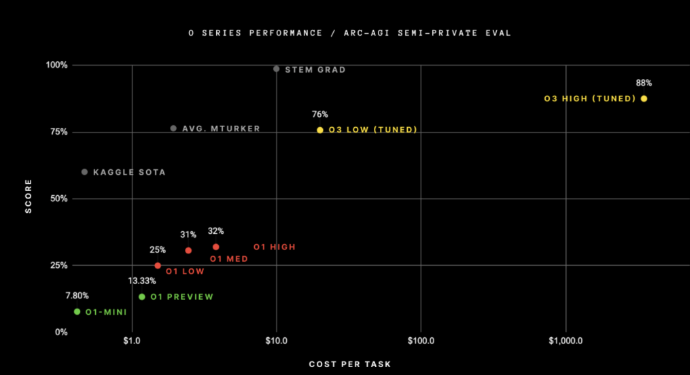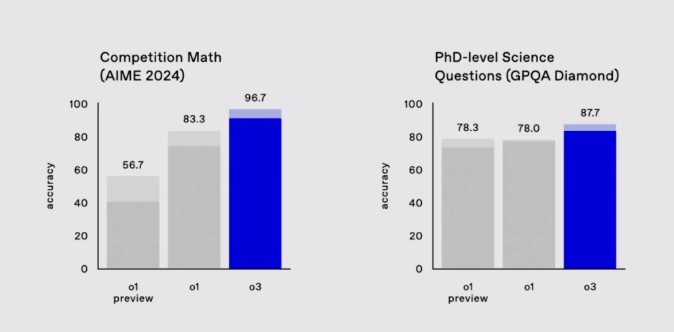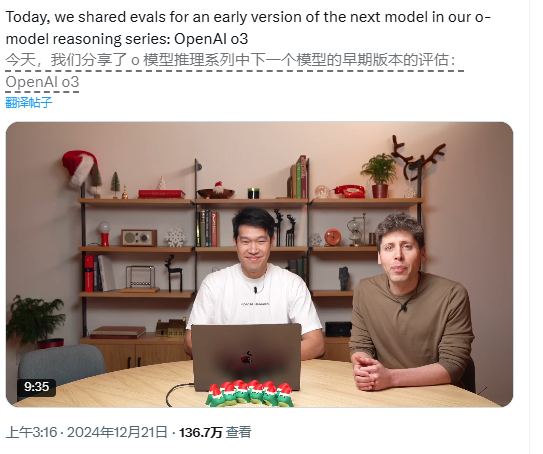OpenAI's latest o-Model reasoning series model, OpenAI o3, has made significant breakthroughs in mathematical and scientific reasoning, and its performance improvements have attracted widespread attention. o3 uses a hybrid reasoning framework that combines neural symbolic learning and probabilistic logic to decompose complex problems and perform multi-step reasoning, effectively solving the limitations of traditional transformation models. The model scored as high as 87% in the ARC AGI benchmark test and achieved a success rate of 96.7% in the advanced mathematics test, demonstrating strong reasoning capabilities.
OpenAI says o3 is designed to improve reasoning capabilities that handle the demands of structured thinking, especially in math and science. The model performed well on ARC AGI, a specialized inference benchmark, with its score jumping from 32% to 87% for the previous model. This advancement marks a significant improvement in o3's ability to solve complex logical and mathematical problems.

The performance of o3 is particularly noteworthy. In the advanced mathematics test, the success rate of o3 reached 96.7%, which was nearly 40% higher than the previous o1 model. In terms of scientific reasoning, o3 also improved its accuracy by 10% when solving doctoral-level scientific problems. In addition, o3 has also shown good capabilities in understanding and debugging code, which provides potential practical value for software development.

o3 adopts a hybrid reasoning framework that combines neural symbolic learning with probabilistic logic. This architecture enables the model to decompose problems and reduce complex queries into smaller, manageable parts; at the same time, o3 is also able to leverage extended memory to maintain contextual information across long interactions and optimize through multiple inference loops Answer. These characteristics make o3 particularly suitable for solving multi-step reasoning challenges that traditional transformation models are unable to meet.
In terms of practical applications, OpenAI o3 has great potential and can play a role in multiple fields. For example, in the field of education, it can help students solve complex mathematical and scientific problems; in the medical field, o3 can support the diagnostic process through data analysis and optimize treatment plans; in software development, it can assist in debugging and generating code to provide Developers provide hands-on support.
OpenAI also released a video demonstrating its vision for AI reasoning, covering o3's problem-solving capabilities in areas such as physics, mathematics, and ethical dilemmas, reflecting OpenAI's ambition to develop models that can reason across multiple scenarios. .

Highlights:
OpenAI o3 scored 87.5% on the ARC AGI benchmark, demonstrating significant improvements in reasoning capabilities.
In the advanced mathematics test, O3's success rate reached 96.7%, and its scientific reasoning accuracy increased by 10%.
o3 has a wide range of application potential and can provide practical support in fields such as education, medical care and software development.
All in all, the emergence of OpenAI o3 marks a significant advancement in AI reasoning capabilities. Its application potential in various fields is huge and deserves continued attention and in-depth research. In the future, the further development and application of the o3 model may profoundly change the working methods and efficiency of many industries.